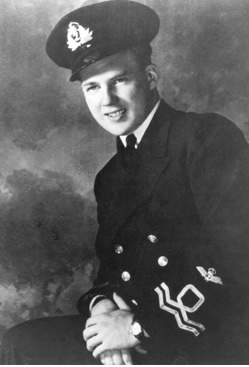Biography
Lieutenant (N) Robert Hampton Gray
 Canada's last Victoria Cross Winner
Canada's last Victoria Cross Winner
Lieutenant (N) Robert Hampton Gray, VC, DSC, has the distinction of being Canada's last Victoria Cross winner.
Gray, also known as Hammy, was born on November 2, 1917 in Trail, British Columbia to John and Wilhelmina Gray. His father, John Gray had served in the South Africa (Boer) War.
Upon graduating from the University of Alberta and the University of British Columbia, Gray had originally intended to attend medical school at McGill University in Montreal. Instead, Gray enrolled in the Royal Canadian Naval Volunteer Reserve at HMCS Tecumseh in 1940. He commenced training as a naval pilot with the Royal Navy's Fleet Air Arm in September 1941.
Gray served flew Hawker Hurricanes in the African campaign for 2 years, then transferred to 1841 Squadron, based on HMS Formidable, flying the Corsair fighter aircraft.
On August 29, 1944, Gray received the first of many awards when he was mentioned in dispatches for his participation in an attack on three destroyers, during which his plane's rudder was shot off.
In April 1945, HMS Formidable joined the Royal Navy fleet in the Pacific Campaign, where Formidable was involved in strikes on the Japanese mainland. Gray earned the Distinguished Service Cross (DSC) for aiding in sinking a Japanese destroyer in the area of Tokyo.
On August 9, 1945 at Onagawa Wan, Honshū, Japan, Gray was killed leading a low level attack on a Japanese destroyer. Wounded, his aircraft in flames and in the face of heavy fire from shore batteries and several Japanese ships, Gray succeeded in sinking one destroyer with a direct hit before his airplane crashed into the bay. His body was never recovered. Gray was one of the last Canadians to die in WWII.
For his actions, Lt. (N) Robert Hampton Gray was posthumously award the Distinguished Service Cross on August 31, 1945 and the Victoria Cross, the highest medal for valour in the British Commonwealth, on November 13, 1945.
The description of his valour from his citation reads as follows:
"For great bravery in leading an attack to within 50 feet of a Japanese destroyer in the face of intense anti-aircraft fire, thereby sinking the destroyer although he was hit and his own aircraft on fire and finally himself killed. He was one of the gallant company of Naval Airmen who, from December 1944, fought and beat the Japanese from Palembang to Tokyo. The actual incident took place in the Onagawa Wan on the 9th of August 1945. Gray was leader of the attack which he pressed home in the face of fire from shore batteries and at least eight warships. With his aircraft in flames he nevertheless obtained at least one direct hit which sank its objective.
Lieut. R.H. Gray, D.S.C., R.C.N.V.R., of Nelson, B.C., flew off the Aircraft Carrier, HMS Formidable on August 9th 1945, to lead an attack on Japanese shipping in Onagawa Wan (Bay) in the Island of Honshu, Mainland of Japan. At Onagawa Bay the fliers found below a number of Japanese ships and dived into attack. Furious fire was opened on the aircraft from army batteries on the ground and from warships in the Bay. Lieut. Gray selected for his target an enemy destroyer. He swept in oblivious of the concentrated fire and made straight for his target. His aircraft was hit and hit again, but he kept on. As he came close to the destroyer his plane caught fire but he pressed to within 50 feet of the Japanese ship and let go his bombs. He scored at least one direct hit, possibly more. The destroyer sank almost immediately. Lieutenant Gray did not return. He had given his life at the very end of his fearless bombing run."
Lieutenant Gray has no known grave as neither he nor his plane were ever found, but his name is inscribed on the Sailor's Memorial in Halifax, Nova Scotia. His Victoria Cross is on loan to the Canadian War Museum in Ottawa.
On 12 March, 1946, the Geographic Board of Canada named a mountain in Kokanee Glacier Provincial Park, BC, after Gray and his brother, John Balfour Gray, who was also killed in WWII. Rising to a height of 2,753m, Grays Peak is well-known in Canada as the mountain pictured on the label of Kokanee beer.
